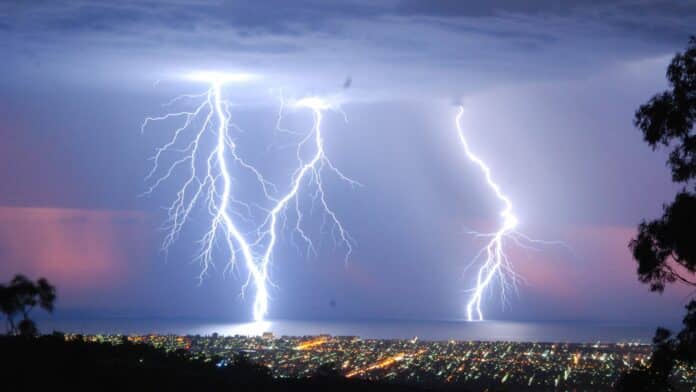An explanation for how lightning moves to the ground in successive luminous stages separated by “dark” intervals of many microseconds is an open question in lightning physics. The structure of the black column that connects the streamer step and the cloud, which can be kilometers long, is electrically conducting but has a very weak sustaining electric field, which is also unknown.
There hasn’t been a definitive explanation until now, with a University of South Australia plasma physicist publishing a landmark paper that solves both mysteries.
Dr. John Lowke, former CSIRO scientist and now UniSA Adjunct Research Professor, says, “There are a few textbooks on lightning, but none have explained how the zig-zags (called steps) form, why the electrically conducting column connecting the steps with the cloud remains dark, and how lightning can travel over kilometers.”
“The answer? Singlet-delta metastable oxygen molecules.”
In essence, lightning occurs when highly energetic singlet delta oxygen molecules are produced when electrons strike oxygen molecules. The “separated” electrons create a highly conducting step after slamming into the molecules; this step is initially bright and redistributes the electric field, resulting in further steps.
When electrons attach to neutral oxygen molecules and are then immediately released by singlet delta molecules, the conducting column that connects the step to the cloud remains dark.
Dr. Lowke says, “We need to understand how lightning is initiated to work out how to better protect buildings, airplanes, skyscrapers, valuable churches, and people.”
“A lightning rod invented by Benjamin Franklin in 1752 is a thick fencing wire that is attached to the top of a building and connected to the ground. It is designed to attract lightning and earth the electric charge, saving the building from being damaged.”
“These Franklin rods are required for all buildings and churches today, but the uncertain factor is how many are needed on each structure.”
“There are also hundreds of structures that are currently not protected, including shelter sheds in parks, often made from galvanized iron, and supported by wooden posts.”
“This could change with new Australian lightning protection standards recommending that these roofs be earthed.”
Journal Reference:
- John J Lowke and Endre Szili. Toward a theory of “stepped-leaders” of lightning. Journal of Physics D: Applied Physics. DOI: 10.1088/1361-6463/aca103
